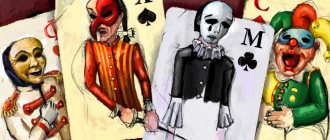General characteristics of emotions and feelings, material on psychology on the topic
General characteristics of emotions and feelings
Currently, the problem of emotions has become quite relevant. The theoretical and methodological aspects of this problem require deep and comprehensive development. The problem of emotions in modern general psychology has been developed significantly less than other areas of psychological knowledge. Any mental phenomenon performs two main functions - reflection and regulation - emotional phenomena carry them out significantly differently than processes called cognitive - sensations, perception, memory, thinking and etc.
It is quite obvious that successful progress in the study of the problem of emotions is possible only with the joint efforts of various areas of psychological science.
Life without emotions is just as impossible as life without sensations. Emotions accompany a person throughout his life. Emotions, Charles Darwin argued, arose in the process of evolution as a means by which living beings establish the significance of certain conditions to satisfy their actual needs. Thanks to emotions, we understand each other better. Many emotional states are inherent in a person from birth: a newborn is able to experience fear when hearing a strong sound, displeasure when movement is limited, and pleasure that arises in response to rocking and stroking. Gradually, from these “embryos” the entire wealth of human emotions grows.
In every society there are norms for the expression of emotions that correspond to ideas about decency, modesty and good manners. People are able to accurately perceive and evaluate the expression of a human face, and determine from it such emotional states as joy, sadness, fear, disgust, surprise.
Without emotions, no person could become aware of his needs, the objects to which these needs are directed, and the motives that directly impel him to act. This same idea has been repeatedly emphasized by almost all without exception researchers of emotions and emotional processes, regardless of what theories they adhered to. According to the characteristics of emotional processes, they believed, one can definitely judge what worries a person at a given moment in time, that is, what needs and interests are relevant for him.
Tasks:
1) Theoretical analysis of literature devoted to the problem of studying emotional processes.
2) Give a general description of emotional processes.
The purpose of this work is to study the general characteristics of emotional processes.
The object is the emotional sphere, the subject is emotional processes, such as affects, emotions themselves, feelings, moods and stressful conditions, passions.
1. THEORETICAL ASPECT OF STUDYING EMOTIONAL PROCESSES AND STATES
Since the time of Plato, all mental life has been divided into three relatively independent entities: mind, will and feelings or emotions.
Emotions always arise and act against our will and desire.
Psychology has recently turned to serious research into the problem of emotions. There are different opinions regarding emotions. Some argue that emotions are not related to behavior. According to others, emotions constitute the primary motivational system of humans. Emotions appeared in humans during the process of evolution. Each emotion performed one or another adaptive function in the process of human evolution.
An emotion is something that is experienced as a feeling that organizes and guides perception, thinking and action. Each aspect of this definition is important for understanding the nature of emotions. Emotion mobilizes energy. This energy in some cases is felt by the subject as a tendency to perform an action. Emotion guides the mental and physical activity of an individual and directs it in a certain direction.
As many researchers of emotions have emphasized (for example, Viliunas, Kruger, Rubinstein, etc.), they reflect the personal significance and assessment of external and internal situations for a person’s life in the form of experiences. This is the subjectivity and involuntary nature of emotions.
Emotions are a person’s experience of his personal relationship to certain phenomena of the surrounding reality. As well as a subjective state that arises in the process of interaction with the environment or when satisfying one’s needs. Emotions are a unique form of reflection of the real process of human interaction with the environment. In emotions, a person shows his attitude to the content of what he knows in the form of pleasure or displeasure, joy, sadness, fear, delight, etc. For example, a rejoicing person gesticulates, children jump and clap their hands, and laugh. If joy gives a feeling of lightness, then in grief there is a feeling of heaviness; the more tense a person is, the less his ability to enjoy and feel happiness. Sadness paralyzes a person. He feels tired and moves slowly. The most accurate signal of changes in emotional state is heart rate.
Emotions can be characterized by several characteristics. Firstly, emotions express the state of the subject and his attitude towards the object. Emotions, secondly, usually differ in polarity, that is, they have a positive or negative sign: pleasure - displeasure, fun - sadness, joy - sadness, etc.
The term “Emotion” (from the Latin emovere - shocking, exciting) means a caring attitude towards various events and situations in life. That is, emotions are the attitude a person experiences towards the world and towards himself.
Emotions are formed in the course of human activity aimed at satisfying his needs. If our needs are met, it gives us positive emotions; that which prevents the satisfaction of needs causes negative emotions in us.
Researchers have proven that numerous physiological changes in the body accompany any emotional state. Throughout the history of the development of this area of psychological knowledge, attempts have been made more than once to connect physiological changes in the body with certain emotions and to show that the complexes of organic signs accompanying various emotional processes are really different.
In 1872, Charles Darwin published the book “The Expression of Emotions in Man and Animals,” which was a turning point in understanding the connection between biological and psychological phenomena, in particular, the body and emotions. It proved that the evolutionary principle is applicable not only to the biophysical, but also to the psychological and behavioral development of living things, that there is no impassable gap between the behavior of animals and humans.
Emotions, according to this theory, appeared in the process of evolution of living beings as vital adaptive mechanisms that contribute to the adaptation of the organism to the conditions and situations of its life. The bodily changes that accompany various emotional states, in particular those associated with the corresponding emotions of movement, according to Darwin, are nothing more than the rudiments of real adaptive reactions of the body.
Charles Darwin's ideas were adopted and developed in another theory, which became widely known in psychology. Its authors were W. James and K. Lange.
James summarizes his theory as follows: “Bodily arousal follows directly from the perception of the fact that caused it: a person’s awareness of this arousal is an emotion. If bodily manifestations did not immediately follow perception, then the latter would be in its form a purely cognitive act, devoid of color and emotional “warmth”.
The James-Lange theory correctly noted the significant role that organic changes of a peripheral nature play in emotions. Without autonomic reactions there are no emotions. They are not only an external expression of emotions, but also a component of them. The James-Lange theory mistakenly reduced emotions exclusively to peripheral reactions. Modern physiology has shown that emotions are not reducible to peripheral reactions alone.
The dynamics of emotional processes were examined by S. Shekhter. He showed that human memory and motivation make a significant contribution to emotional processes. The concept of emotions proposed by S. Schechter was called cognitive-physiological.
According to this theory, the emotional state, in addition to perceived stimuli and the bodily changes generated by them, is influenced by a person’s past experience and his assessment of the current situation from the point of view of his current interests and needs.
According to P.V. Simonov, emotions are associated with needs. But the nature of emotions depends on whether a person has sufficient information about the means of satisfying this need. If there is little information and a person does not know how to satisfy a need, the emotion is negative.
So, to summarize, it should be noted that theories help explain a person’s actions, his actions in various situations. Emotions largely depend on a person’s lifestyle. A person (if he is mentally healthy) strives to receive as many positive emotions as possible and as little negative emotions as possible.
An important unresolved issue in the general psychology of emotions is the issue of classification of emotional processes. Emotions are systemic phenomena. Isolating systemic qualities and their objectification will make it possible to construct a consistent classification of emotions.
Dodonov B.I. offers his own special approach to solving this issue. The object of attention is the emotions in which the subject most often feels the need and which add value to the process of his activity. B.I. Dodonov’s classification includes emotions that appear in people’s minds as “valuable” experiences.
1. Altruistic emotions. These experiences arise from the need for assistance, help and protection from other people.
2. Communicative emotions. These emotions arise based on the need for communication.
3. Gloric emotions. These emotions are associated with the need for self-affirmation and glory.
4. Praxic emotions are experiences that are caused by an activity, its change in the course of work, its success or failure.
5. Scary emotions. Emotions stemming from the need to overcome danger, on the basis of which later an interest in fighting arises.
6. Romantic emotions. By romanticism we mean the desire for everything extraordinary, extraordinary, mysterious.
7. Gnostic emotions. We associate these emotions with the need for “cognitive harmony.” Its essence is to find the familiar, familiar and understandable in the new and unknown.
8. Aesthetic emotions. To this day, much remains unclear regarding the nature and composition of aesthetic experiences. There are two main views on this problem. According to the first, aesthetic emotions simply do not exist in their pure form. According to the second view, aesthetic emotion is a reflection of a person’s need for harmony with the environment, which is “correspondence, coincidence of the measures of a person and the measures of objects.” This correspondence is reflected in the feeling of beauty.
9. Hedonic emotions. These are emotions associated with satisfying the need for bodily and mental comfort.
10. Active emotions. These emotions arise in connection with an interest in accumulating, “collecting” things that go beyond the practical need for them.
This is the classification of emotions according to B.I. Dodonov.
V.K. Vilyunas distinguishes two groups of emotional phenomena: 1) leading emotional phenomena, 2) derivative emotional phenomena. Leading emotional phenomena encourage activity and are responsible for its general direction. They are relevant to the activity as a whole. They largely determine the direction of emotional life. Derived emotional phenomena are phenomena that arise already in the presence of a leading impulse, that is, in the process of activity, and express a certain attitude of the subject to individual conditions that favor or hinder its implementation (fear, anger), to specific achievements in it (joy, grief) , to existing or possible situations, etc.
Division of emotions according to their subjective experience. There are two categories here: positive emotions, which are associated with the satisfaction of a person’s life needs and therefore give us pleasure, and negative emotions, associated with the dissatisfaction of life’s needs and causing displeasure.
.
All emotions can be classified according to their content. At the same time, simple and complex emotions are distinguished. The simpler ones include anger, fear, joy, grief, envy, jealousy. More complex ones include moral feeling, aesthetic feeling, etc.
Finally, the following emotional processes are distinguished: feeling tone, mood, affect, emotions themselves, stress, frustration, passion, higher feelings. This classification was proposed by E.I. Rogov.
Emotional states have their own history and development in humans. At the same time, their functions change and their differentiation occurs, so that they form significantly different levels and classes. These are affects that arise suddenly and involuntarily; further, these are emotions themselves - predominantly situational states; they are associated with objective feelings, that is, stable, “crystallized” emotional experiences in an object; finally, these are moods - subjective phenomena that are very important in their “personal” function. These classes of emotional states enter into complex relationships with each other.
Reed built a classification based on the relationship to the source of action. He divided all emotions into three groups: 1) emotions that are characterized by a mechanical origin (instincts, habits); 2) emotions with an animal origin (appetite, desire, affectation); 3) emotions with a rational beginning (pride, duty).
I. Kant reduced all emotions to two groups, which were based on the reason for the emergence of emotions: sensory and intellectual. He attributed affects and passions to the volitional sphere.
A. Ben identified 12 classes of emotions. The founder of scientific psychology, V. Wundt, believed that the number of emotions is more than 50,000.
L.V. Kulikov divides emotions into activation ones, which include cheerfulness, joy, excitement; tension (emotions of tension) – anger, fear, anxiety; and self-esteem - sadness, guilt, confusion.
So, to summarize the above, it should be noted that attempts to give universal classifications of emotions were made by many scientists, and each of them put forward their own basis for this. Theories of emotions help explain human actions in different situations. Emotions are considered as the main motive for corresponding human actions and actions.
2. EMOTIONAL PROCESSES. THEIR CHARACTERISTICS.
A person is born with a certain set of emotional reactions. These emotions are called primary. These include fear and anxiety as an expression of the need for self-preservation, joy that arises from the satisfaction of vital needs, and anger as a consequence of the restriction of the needs for movement.
At a later age, as a result of communicating with people, as a result of the formation of one’s own “I,” secondary emotions arise. They are not related to vital needs. But this does not make them less significant; they are the ones who bring the greatest suffering and joy.
Emotional processes (phenomena) are divided into affects, stress states, moods and actual emotions and feelings.
Affects almost always occur in the form of a tension reaction. According to V. Vitvitsky, affect is a sensory state that “acquires very significant strength and becomes a general violent disturbance of mental life.” He included such emotional reactions as fear, horror, anger, etc. as affects. A.N. Leontyev wrote that affects arise in response to a situation that has already actually occurred. Affect is nothing more than a strongly expressed emotion. Any emotion can reach the level of affect if it is caused by a strong or particularly significant stimulus for a person.
Affect as a type of emotion is characterized by:
1) rapid occurrence;
2) very high intensity of experience;
3) short duration;
4) violent expression (expression);
5) lack of accountability, i.e. decreased conscious control over one’s actions; In a state of passion, a person is unable to control himself. With passion, little thought is given to the consequences of what is being done, as a result of which a person’s behavior becomes impulsive.
6) diffuseness; strong affects take over the entire personality, which is accompanied by a decrease in the ability to switch attention, a narrowing of the field of perception, the control of attention is focused mainly on the object that caused it.
Affective manifestations of positive emotions are delight, inspiration, enthusiasm, a fit of unbridled fun, and affective manifestations of negative emotions are rage, anger, horror, despair. After the emotion, there often comes a loss of strength and indifference to everything around you or remorse for what you have done.
Frequent manifestations of affect in a normal environment indicate either a person’s bad manners or a neuropsychiatric illness.
However, this understanding of affect is not consistent with the use of the term “affect” to refer to any emotional reactions, which is characteristic of Western psychology.
According to S.L. Rubinstein, affect is a rapidly and violently occurring emotional process of an explosive nature, which can provide a release in action that is not subject to conscious volitional control. It is affects that are primarily associated with shocks - shocks expressed in the disorganization of activities.
Affect arises as a reaction to an event that has already occurred and is, as it were, shifted towards its end. For example, grief at the loss of a loved one, anger at betrayal, joy at success - all of this is experienced as if after what has already happened.
Any feeling can be experienced in an affective form. Affect speaks of a very strong experience.
There are two types of affect:
1) Pathological. Is a consequence of mental illness, occurs in the absence of consciousness
2) Physiological. Occurs in a normal person. Physiological affect occurs with preserved consciousness.
There are two types of pathological affect:
1) holothymic
2) catathic.
Affect, referred to as holothymic, is a “non-objective” emotional phenomenon that arises as a result of physiological events.
Phenomenologically, catathymic affect is an emotional phenomenon associated with significant areas of a person’s existence, with his values and motives. Structurally, this affect is similar to normal emotion. Catathymic affect cannot be discharged.
In genetic terms, holothymic affect is associated with disorders at the biological level.
A correct understanding of affect is of great importance for pedagogy and for the practice of forensic psychiatry. Disorders of mental activity during affects show how internally and mutually determined all mental processes are.
Among emotional states, emotional tension is distinguished, characterized by an increased level of activation.
The word stress has different meanings for different people. Therefore, it is very difficult to define it, although it has become part of our everyday speech. As Yu.G. Chirkov notes, stress is contradictory, elusive, and vague. It hardly fits into the narrow framework of definitions. Its weakness lies in uncertainty and vagueness of boundaries.
G. Selye believes that the word “stress” came into English from Old French and Medieval English and was initially pronounced as “distress”. Then the first syllable disappeared due to smearing or “swallowing.” There is a point of view that the word “stress” comes from the Latin “to tighten.”
G. Selye interprets the concept of “stress” differently. If in his first works stress was understood as the totality of all nonspecific changes that occur in the body under the influence of any strong influences and accompanied by a restructuring of the body’s defenses, then in later works stress was understood as a nonspecific reaction of the body to any demand placed on it, that is, a simplification occurred this phenomenon and concept.
G. Lazarus was the first to try to distinguish between the physiological and psychological understanding of stress. He put forward a concept according to which a distinction is made between physiological stress associated with exposure to a real physical stimulus, and mental (emotional) stress associated with a person’s assessment of the upcoming situation as threatening and difficult.
At the final stage of developing his skill, G. Selye talks about two types of stress - distress, which is associated with negative emotional reactions, eustress, associated with positive emotional reactions. This led to the fact that all physiological phenomena, including sleep, entered the sphere of concepts.
That is, stress (from the English word stress - tension) is an emotional state that occurs in the event of danger, great physical, mental overload, that is, in an unusually difficult situation. It is experienced with great internal tension. Often such experiences arise when it is necessary to make quick and responsible decisions, etc. Extreme life experiences - insults, threats, disappointments, betrayals, unexpected danger, disasters - require a person to mobilize his neuropsychic forces. Experiencing these situations causes an acute form of emotional state, that is, stress.
Stress disorganizes a person’s activities and disrupts the normal course of his behavior. Stress has a negative impact not only on a person’s psychological state, but also on a person’s physical health.
Currently, depending on the results of stress, scientists distinguish between eustress (positive stress, which is combined with a desired effect and mobilizes the body) and distress (negative stress with an undesirable harmful effect).
Depending on the stressor, different types of stress can be distinguished, which can be reduced to physiological and mental stress.
G. Selye identified three stages in the development of stress. The first stage is the alarm reaction - a phase of mobilization of the body's defenses, increasing resistance to a specific traumatic impact. The second stage is the stabilization stage, in which all parameters brought out of balance in the first phase are fixed at a new level. If the stressful situation continues to persist, the third stage begins - the stage of exhaustion, accompanied by loss of strength, deterioration of well-being and even death.
Thus, affect and stress are emotional processes that differ from each other in their specific form of occurrence. But in the emotional sphere of a person, such emotional processes as mood and actual emotions and feelings are also distinguished.
Of all emotional phenomena, mood is the most vague, vague and almost mystical.
In most psychology textbooks, mood is described as an independent emotional phenomenon, different from emotions.
According to L.S. Rubinstein, “Mood is not a special experience associated with some particular event, but a diffuse general state. The mood is partly more complex and, most importantly, more iridescent - diverse and mostly vague, richer in subtle shades than a clearly defined feeling.” Rubinstein emphasizes that mood, unlike other emotional experiences, is personal.
The mood in most domestic psychology textbooks is characterized by:
1) low intensity;
2) significant duration - the mood can last for hours, or even days;
3) sometimes the uncertainty of its cause; When experiencing this or that mood, a person, as a rule, is poorly aware of the reasons that caused it, and does not connect it with certain people, phenomena or events.
4) influence on human activity; being inconsistently present in a person as an emotional background, it increases or decreases his activity in communication or work.
Speaking about the types of mood, we can say that it can be good (sthenic) and bad (asthenic). In the first case, with its stable manifestation, they speak of hyperthymia, that is, elevated mood. It is characterized by elation, cheerfulness, and optimism.
The second manifestation of a good mood is euphoria, which is characterized by carelessness, serenity, carelessness and at the same time an indifferent attitude towards the serious aspects of life.
That is, mood is a general emotional state that colors all human behavior for a significant period of time. The mood can be joyful or sad, cheerful or lethargic, etc.
People differ in the outward expression of their mood. For some people, their mood can always be read on their face, while other people disguise their mood well, so that it is difficult to guess about it from a person’s appearance.
Emotions are long-term states, sometimes only weakly manifested in external behavior. They have a clearly defined situational nature and express an evaluative personal attitude towards emerging or possible situations. Emotions themselves have a clearly expressed ideational character. This means that they are able to anticipate situations and events that have not yet actually occurred, and arise in connection with ideas about experienced or imagined situations. Their most important feature is their ability to generalize and communicate; therefore, a person’s emotional experience is much broader than the experience of his individual experiences. The very expression of emotions takes on the features of a socially emerging, historically changeable “emotional language.” Actually, emotions have a different relationship to personality and consciousness than affects; the former are perceived by the subject as states of my “I”. the second - as states occurring “in me.” This difference clearly appears in cases where emotions arise as a reaction to affect; for example, it is possible that the emotion of fear of the appearance of an affect of fear or an emotion caused by an experienced affect, for example, the affect of acute anger, may appear. A special type of emotions are aesthetic emotions, which perform a vital function in the development of the semantic sphere of the individual.
Emotions themselves are a long-term emotional state that arises not only in response to completed events, but mainly in response to supposed or remembered ones. Emotions reflect an event in the form of a generalized subjective assessment.
Another feature of feelings is that they form a number of levels, ranging from immediate feelings towards a specific object and ending with higher social feelings related to social values and ideals. Feelings are personal. They reflect the significance of objects and phenomena for a given person in a specific situation. As a rule, objects that we dealt with in a joyful, emotional environment will continue to evoke a positive reaction in us. And unpleasant or sad events are unlikely to cause joy later. In this regard, feelings can be considered as the most important characteristic of a person.
Feelings reflect a person’s attitude towards objects and carry information about them. In this sense, we can talk about the cognitive component of emotions. Even when meeting this or that object, this or that person for the first time, we experience some feelings for him.
Feelings are closely related to the needs of the individual. Behind every human emotion there is a specific need. That is, feelings are generated by two reasons. On the one hand, the needs of a person, and on the other, his ability to reflect and understand certain properties of this object.
Feelings are characterized by direction. The same feelings can have different directions.
Emotions are elementary experiences that arise in a person under the influence of the general state of the body and the process of satisfying current needs.
Emotional processes include a wide class of processes of internal regulation of activity. They perform this function, reflecting the meaning that objects and situations that affect the subject have.
In the course of their development, emotions are differentiated and form different types in a person, differing in their psychological characteristics and patterns of their course.
Emotions are divided into actual emotions, feelings, mood, affect and stress. Parameters by which emotional processes and states are characterized: intensity, duration, depth, awareness, conditions of emergence and disappearance, direction, dynamics of development.
Some researchers argue that emotions cannot develop because they are associated with the functioning of the body and with its features that are innate. Another point of view expresses the opposite opinion - that the emotional sphere of a person develops.
In fact, these positions are quite compatible with each other and there are no insoluble contradictions between them. Elementary emotions, acting as subjective manifestations of organic states, really change little. But already in relation to affects and especially feelings, such a statement is incorrect. These emotions develop. That is why knowledge of emotional processes will help to learn how to manage emotions, and psychologists will correctly make the psychological selection of individuals for activities in extreme conditions, and create a favorable psychological climate in the team, which is so necessary at the present time.
Glossary
| No. | Concept | Definition |
| 1 | Affect | a strong, quickly emerging and rapidly occurring mental state, characterized by strong and deep experience, vivid external manifestation, narrowing of consciousness and decreased self-control. |
| 2 | Feeling | An emotional process of a person, reflecting a subjective evaluative attitude towards real or abstract objects. |
| 3 | Fear | an internal state caused by a threatening real or perceived disaster |
| 4 | Passion | this is a strong emotional feeling that focuses a person’s thoughts, emotions, and desires on itself |
| 5 | Mental illness | a state of mind that is different from a normal, healthy one. |
| 6 | Emotion | an emotional process of medium duration, reflecting a subjective evaluative attitude towards existing or possible situations. |
| 7 | Expression | expressiveness, the power of manifestation of feelings and experiences. |
| 8 | Mood | the prevailing emotional state (cheerful, sad, anxious, etc.), affecting the state of mental activity and motor activity. |
| 9 | Dream | this is a natural physiological process of being in a state with a minimum level of brain activity and a reduced reaction to the outside world |
| 10 | Distress | a destructive process that worsens the course of psychophysiological functions. |
Function of emotions
Emotions perform several functions at once.
Firstly, they motivate . Positive emotions ( joy, pleasure, happiness)
attract and encourage us to take the “right” action, while negative ones (
fear, irritation, grief)
punish us for the “wrong” and push us away from it. In this sense, emotions provide us with the necessary fuel.
Secondly, emotions give us access to certain behavioral strategies . A person in anger will act completely differently than in joy.
Thirdly, they provide certain information . For example fear
it tells us that there is danger and can be dealt with,
happiness -
that our values are satisfied,
anticipation -
that the desired event will definitely happen,
irritation
tells us that the situation is not developing as expected, and for the worse.
And fourthly, emotions are extremely important in communication . Demonstration of emotion informs others about the assessment of the situation, and this in many cases is much more important than the content.
So, what have we got?










